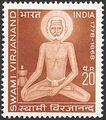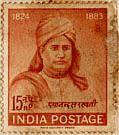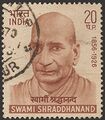Arya Samaj
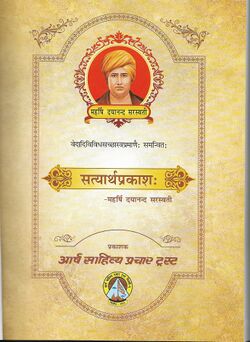
The Arya Samaj had a very significant impact on the emergence of the community as a cohesive one with self-confident identity. Within a few decades with begining in the 1880s, the Arya Samaj gained major support from the Jats. It remains, even today, as a major belief system among the (Hindu) Jats. At present Sarvdeshik Arya Pritinidhi Sabha ( World Council of Arya Samaj) is headed by Swami Aryavesh. Naresh Kadyan is a National Convenor for the Pashu Pakshi Raksha Adhikar Samiti under the Sarvdeshik Arya Pritinidhi Sabha (World Council of Arya Samaj).
This section on the Arya Samaj gives a brief introduction to the Arya Samaj, its origin and its role with respect to Hinduism.
Introduction
|
The Arya Samaj is a socio-cultural organization founded by Swami Dayanand Saraswati in 1875. It is not a seperate religion but a reform movement within Hinduism. The mission of the Samaj is to mould the lives of its members and all others according to the message of the Vedas with reference to the circumstances of time and place.
Swami Dayanand came at a time when the pure Vedic traditions of scientific adventure, spiritual exploration, philosophical enquiry, intuitive vision, social experimentation and moral renewal had been closed. Indeed, there was a defensive wall of elaborate ritual, rigid custom, empty formulae, and ridiculous superstition.
Swami Dayanand challenged superstition on the one hand and pseudo-modernity on the other. He wanted to redeem the original knowledge of the Vedas, rejuvenate the society and point the way to a dynamic modernity through constant renewal by education. "Back to the Vedas for the message", he said, "look round and remodel the forms of living for the material, spiritual and social progress of the world". He founded the Arya Samaj for the realization of its new program.
The Arya Samaj is a voluntary organization working across the world for physical, moral, spiritual and professional education, eradication of superstition, inculcation of universal values, comparative study of cultures, religious and social systems, with open enquiry and debate for the propagation of truth. The organization is thoroughly democratic and works on the basis of the ten principles formulated by the founder. The principles are universal and have no tinge of sectarianism at all.
Arya Samaj and Hinduism: A Reform Movement
The Arya Samaj was founded in 1875 AD by Swami Dayanand Saraswati. It was and continues to be a reformist movement in India and within Hinduism worldwide. It is not a separate religion nor is it a sect within Hinduism. Its primary task is to reform Hindu-Dharma, which has been corrupted over the ages.
The following issues are central but not exclusive to the Arya Samaj's role within Hinduism.
The Use of Murti (idol) Worship

The Arya Samaj "rejects [idolatry] entirely, not only as a harmless error, but as a positive sin". This is so in that there is only one God, but that God takes on an infinite number of forms.
According to this position, worship of God consists in 3 acts:
- the first and foremost is to study the Vedas, with the motivation to acquire knowledge of God.
- the observance of Dharma (moral duty and action) as prescribed by God in the Vedas.
- worship of God by fire or the homa-sacrifice, this involves the use of the Gayatri Mantra.
In addition to the rejection of murti worship, the Arya Samaj rejects the avatars of Hinduism and of the Christian incarnation. How is one follow in the footsteps of God (Jesus or Rama), we are simply human ? Most of all is the rejection of the harmful and factless stories of the Puranas which perpetuates itself as the truth (i.e. the stories of Krishna having thousands of Gopis as wives).
Caste
With respect to caste, it is the total rejection as it is now known. This is the say. it is not a natural account of a human's life nor as a truth from God. It is simply a means to organise society. Caste is formed only by one's character and not by birth (see the story of Stayakama in the Chandogya and Brihadaranyaka- Upanishads). How can a coward be born as a Ksatriya or a person who has no knowledge of the Vedas as a Brahman ?
Swami Dayanand fought against the soul repression that caste wrought upon the Indian people. As a result of repressive Mughal rule, caste became solidified in order to protect Hindu-Dharma. Now, caste totally needs to be changed and everyone must be treated equally and given the right to study the from the Vedas.
The Vedas
The Vedas were created by God as prior to the creation of the universe and given to the ancient rishis. It contains all the fixed truths of the universe, the True Knowledge. Such laws are unchangeable (i.e. Karma, Dharma and Physical laws), they are not of the changeable type (i.e. this webpage has the colour 'x').
The problem that arises is that Vedic Sanskrit is radically different from Classical and Epic Sanskrit, the result has been many misinterpretations by Western scholars. For example, "Ashva" means "horse" and "grain". Sacrifices which call for "Ashva" were assumed to be for horses but the correct Vedic interpretation is that of "grain". The point being is that Vedic Sanskrit must be read in respect to the Vedic context.
Beliefs
- The Arya Samaj does not believe in the infallibility or immunity from mistakes. To err is to be human.
- The only appropriate forms of worship are that of the fire (havan).
- The Arya Samaj believes in the Law of Karma. This is the truth that "acts must follow by their consequences, that the result of actions cannot be warded off or atoned by any means". This is in connection with the theory of reincarnation.
- The Arya Samaj does not believe in "Fate". Those born in a lowly position are not condemned to live a life of despair. It is the soul system that has degraded people to punish them for the positions of the rich and powerful.
- Everyone can make and unmake his or her destiny through the Law of Karma.
- The Vedas are infallible and expects every woman and man to know them and to expound them for the benefits of others.
The Basis of the Arya Samaj - The Vedas
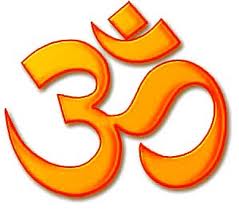
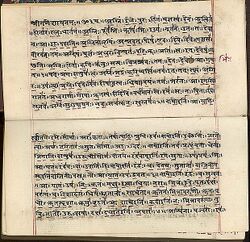
The Vedas had a decisive influence on the trends in Indian culture and its belief systems. Of course, the requirements of modern life have changed many of the customs and the elaborate sacrifices (yajna) of which the Vedas speak of, which have gradually became less important after the Vedic age. Indeed it is the doctrine of ahinsa (non-violence and non-hatred) of sects such as Jainism and the Buddhists, which gained respect later. There are other non-Vedic notions to be found in Hinduism today, such as the worship of Shakti, the Vaishnava approach through devotion or bhakti, and ideas of asceticism, renunciation, and continence, but the Hindu nevertheless persists in thinking of [one's] religion as being according to the Vedas and in looking upon the Vedas as the embodiment of revealed literature.
By the Vedas we generally mean the Vedic Sanhitas, which are collections of prayers and ritual formulae. Their main heroes are the gods and the recurring motive of their worshippers is propitiation. The so-called 'way of works' (karma vidhi) is a way of pleasing the celestial governors of human destiny. In the course of time, rituals grew and multiplied whose meaning only the experts knew. Possibly the later search for the ways of knowledge (jnana) and devotion (bhakti) began in a dissatisfaction with this elaborate ritualism of the Vedic religion. The birth of the Upanishads, with their emphasis on knowledge and meditation, and the Bhakti literature, with its emphasis on love and adoration, were revolts against the formalism of the Vedic system.
The Vedic Aryans were divided into different groups, but they were held together by a common worship of their gods and by their ordering of religious observance. In their view, [one's] life was in the hands of the gods, to be killed or raised to a status with their own. The correct performance of sacrifices brought earthly increase and an assured comfort in the heavens above, the ideal of Vedic [life]. It is only in the Atharvaveda that one hears of men along with the gods and the heavens. This may be one of the reasons why the orthodox have always frowned upon the Atharvaveda; it contains references to many non-Vedic influences, such as the prayers of the outcastes (Vratyas) who opposed sacrifices.
There are four Vedas: Rig, Yajur, Sama and Atharva. The oldest and most important of these is the Rigveda. It which consists of 1,028 hymns divided into eight or ten books. The Atharva may be mentioned next in order of importance. It contains a large number of magical formulae and contains definite pre-Vedic influences. Atharva literally means the Fire Priest. Many of its verses are also found in the Rigveda. Some of the mantras do not seem to be heavily endowed with spiritual meaning, but from time to time one comes across utterances of very considerable sophistication which elevate the character of the entire anthology and make one feel that there is clearly more in it than meets the eye.
The Sama contains a large number of [Rig] mantras. These mantras used to be sung and there are instructions for the tunes. The Yagurveda deals mainly with works of sacrifice and is divided into two parts. Most of the Vedas had various divisions and subdivisions, not all of which have survived, partly because they were long transmitted by word of mouth.
On the time of the composition of the Vedas, opinions differ. Modern scholars do not consider them as ancient as the majority of Indians have done so far. Winternitz thought the Vedas belonged to a period stretching from 2500 B.C. to 7000 B.C., but most scholars today would certainly put the origin at a date later than 2500 B.C. In a document of about 1300 B.C., the Mitannian king Mattiuaza is found invoking the gods Mitra, Varuna, and Indra of the Hindu pantheon; so the roots of the Vedas certainly stretch at least to the middle of the second millennium B.C. It may be mentioned in passing that religiously-minded people often have little interest in fixing the date or the age of their beliefs. More than the history it is the revelation itself that interests the Hindu.
Most of the Vedic gods are taken from nature: the sun, the moon, fire, sky, storm, air, water, dawn, rain, and so on. Indra, the god of rain and thunder, seems to have enjoyed a greater importance than others. The hymns to the gods contain some wonderful pieces of poetry. They even include abstract notions such as sky and space deified into Prajapati and Varuna. Varuna later changed into the god of good and evil, of the right law, Prajapati became the one Lord of all creation, the force than runs the world. Even Faith was deified. The hymns to Night and to the Forest show, besides the spiritual significance that may be attached to these largely esoteric writings, an extraordinary sensitivity to the beauties of the physical universe. The hymns to Usha (dawn) and Vak (speech) are equally marvellous as poetry.
The Rishis were fully aware of the importance of the subtle and the abstract. The Atharva contains hymns to Life and Time. Similar consciousness of the abstract is seen in the hymn to Vak (speech) referred to earlier. One of the Vedic mantras that forms part of the daily worship of the Hindus is the Gayatri Mantra (Rigveda, 3, 62, 10). Its main theme is: "We contemplate and adore the knowledge and power of the World-Creator who infuses the intellectual faculties in us."
Yajna was the chief method of sacrifice. The performance centered around a sacrificial fire and offerings were thrown into it. On the very rare occasion, offerings were thrown into water. The offerings consisted of materials of which the owner was fond and very often included things like butter, milk, meat, grains cooked in milk, intoxicating drinks, and other such items.
There are some differences of opinion on the purpose of the yajnas. First, yajnas can be looked upon as the methods of pleasing gods by giving them parts of one's wealth. Secondly, yajnas can stand for token offerings made to gods to indicate obedience and allegiance. Finally, quite irrespective of the gods, the sacrifices can be looked upon as methods of practising renunciation. There can be little doubt that the yajnas began as methods of pleasing gods, and that their significance changed with time until integration with renunciation and other ideas of later Hindu philosophy was eventually achieved.
Gradually the idea of monotheism began to grow around Prajapati and Varuna. The Vedas declare: "He is one, (though) wise men call Him by many names"(Rigveda, 21, 164, 46). The Mahabharata declares all Vedas to be one and the same. The Truth is one; it is our ignorance that divides it . The Supreme is not merely an architect but a creator, and He creates out of himself. The universe is born of His delight. This idea of an infinite being projecting Himself in many names and forms is first mentioned in the Samhitas and later elaborated in the Upanishads. The Supreme is not bound by His creation, for His nature is freedom. The world is an expression of his play (lila), His delight. We are parts of That. This identification of the Atman (self) with the Brahman (the Supreme) is expressed in the Upanishads as a message to all [people], "Tat tvam asi," "Thou are That." The object of human life, according to this view, becomes unity with the Source. While this idea is developed fully in the Upanishads, it is in the Vedic Samhitas that one meets it first. If we look down the centuries the Vedas stand out as the origin of much that is noteworthy in Hinduism.
Maharishi Swami Dayanand Saraswati
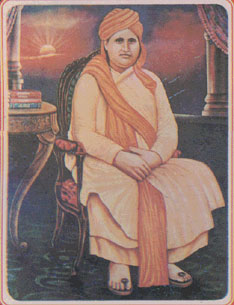
Swami Dayanand Saraswati (1824-1883), born on 12th February 1824 (in Tankara in the State of Gujurat, India), was the founder of the Hindu reform organization known as Arya Samaj, which he established on April 7th 1875, in Bombay India. He also created the 10 principles of Arya Samaj. Throughout his life, Swami Dayanand preached against many Hindu traditions which he felt were dogmatic and oppressive. These included traditions such as idol worship, caste by birth and the exclusion of females from the study of the Vedas. One of his main messages was for Hindus to go back to the roots of their religion, which are the Vedas. By doing this, he felt that Hindus would be able to improve the depressive religious, social, political, and economic conditions prevailing in India in his times.
One of Swami Dayanand's major arguments for going back to the Vedas was that, in his own words " the four Vedas, the repositories of knowledge and religious truth, are the Word of God. They are absolutely free of error, and the Supreme and independent authority ". The four Vedas are; Rig Veda, Yajur Veda, Sama Veda and Atharva Veda. To spread awareness of his movement and to revitalize Vedic knowledge, Swami Dayanand published many religious books. These include; Satyartha Prakash ( The light of Truth ), the Rig-Vedaadi, Bhasyya- Bhoomika, and Sanskar Vidhi.
Swami Dayanand gave many messages to Hindus during his lifetime. For instance, he preached that Hindus should worship just one, formless God. He fought against polytheism by telling people the true meaning of many names of God and established how all of them pointed at one and the same God- Paramathama, the Supreme Self. Further, Swamiji raised his "voice against superstition, against unrighteousness, which reigned supreme in the garb of true religion, and against a foreign rule".
Throughout his known life, Swami's main message was " Back to the Vedas ". By this, Swami Dayanand meant that Hindus should stop practising beliefs such as idol worship, caste, polytheism, pantheism, untouchability, child marriages,forced widowhood, and many other practices which he felt were wrong. He challenged many of the Hindu orthodoxy if they could justify their belief in the aforementioned practices. This induced the anger and wrath of many orthodox Hindus, which subsequently led to 14 attempts at poisoning Dayanand. Miraculously, he was able to use his Yogic abilities to cure himself from the first 13 attempts. However, the 14th time proved fatal. Swami Dayanand died, and left the world with his legacy, Arya Samaj.
Prominent Jats associated with Arya Samaj
- Anand Muni Vanparsth/Bhim Singh
- Bhagat Singh Sandhu
- Bhakt Phool Singh
- Bharat Singh Arya
- Captain Bhagwan Singh
- Chaudhary Bahadur Singh Bhobia
- Chaudhary Charan Singh
- Chaudhari Ishwar Singh Gehlawat
- Chaudhary Kumbha Ram Arya
- Chaudhary Matu Ram
- Choudhary Ranbir Singh Hooda
- Chaudhary Vinay Chhikara
- Chaudhary Priya Vrat
- Chaudhary Kabul Singh
- Chaudhary Hira Singh
- Daulatram Saharan
- Dharampal Singh Bhalothia
- Dharmpal Singh Dudee
- Dr. Om Parkash Kadyan
- Dr. Sahib Singh Verma
- Dr. Yoganand Shastri
- Hans Raj Arya
- Harish Chandra Nain
- Hari Singh Burdak
- Har Lal Singh
- Hoshiyar Singh Thakran
- Jagdev Singh Sidhanti
- Kunwar Hukam Singh
- Master Alamchand
- Master Chandrabhan
- Master Dalel Singh
- Mool Chand Siyag
- Naresh Kadyan
- Nathuram Mirdha
- Piru Singh Dahiya
- Prof. Sher Singh
- Prithvi Singh Bedharak
- Raghuvir Singh Shastri
- Ram Chander Bainda
- Ram Niwas Mirdha
- Sardar Ajit Singh
- Seth Chhaju Ram
- Shiv Karan Sangwan
- Sir Chhotu Ram
- Sompal Singh Shastri
- Swami Gopal Das
- Swami Indravesh
- Swami Keshwanand
- Swami Swatantranand
- Swami Omanand Sarswati
- Tara Chand
- Thakur Deshraj
Jats and Arya Samaj
Jats are the true inheritors of Vedic culture. They are following the Vedic principles and have not accepted superstitious practices. It was but natural that Arya Samaj movement spread more rapidly in Jat dominated areas of Punjab (including Pakistani part of Punjab), Haryana, Rajasthan and Uttar Pradesh - the charisma of Swami Dayanand worked in Jat areas more than Swamiji's home state (Gujarat). Swamiji knew this Jat factor and in his writings, he has quoted Jats. Reproduced is an excerpt (in Hindi) from Chapter XI of Satyarthprakash (सत्यार्थ प्रकाश) where a Jat refuses to accept superstition of 'Godan' after the death of his father.
सत्यार्थ प्रकाश में जाटजी और पोपजी की कहानी
यह कहानी यहाँ पढ़ें - जाटजी और पोपजी की कहानी
धर्म रक्षक आर्य समाज
आर्य शब्द हमारी संस्कृति का सम्मान जनक शब्द है। हमारे वेदों में, सनातन धर्म ग्रंथो में, रामायण गीता महाभारत नीतियों में श्रेष्ठ पुरुषों को आर्य कहकर ही संबोधित किया जाता था। भगवान श्रीकृष्ण, धर्मराज युधिष्ठिर, अर्जुन को भी आर्य नाम से संबोधित किया गया है।
हिंदू शब्द मुगलकालीन समय से मुगलों द्वारा दिया गया है। आर्य का अर्थ होता है श्रेष्ठ। आर्य समाज की ठीक से पहचान न होने के कारण समाज इसके महत्व को समझ नहीं पाया जबकि सत्य सनातन धर्म को पूरी तरह मानते हुए और उसका प्रचार प्रसार करना इसका मुख्य उद्देश्य है।
भारतवर्ष के अतिरिक्त 30 से अधिक देशों में आर्य समाज की शाखाएं फैली हुई है। इसके अंतर्गत आर्य समाज मंदिर, वृद्ध आश्रम, गुरुकुल, अनाथालय, अस्पताल, विद्यालय, महाविद्यालय, विश्वविद्यालय, गौशालाएं, व्यायाम शालाएं, योगासन केंद्र आदि हजारों की संख्या में संचालित होते हैं।
सनातन धर्म का उद्गम वेदों से हुआ है। यह वेद परमात्मा की वाणी है। संसार का सबसे पहला ज्ञान, सबसे पहली संस्कृति, यही ईश्वरीय ज्ञान है। यह सब के लिए सदा के लिए तथा मानव जीवन की सभी पवित्र इच्छाओं को पूर्ण करने का ज्ञान है। इसमें समाहित है सुख, शांति, मोक्ष, संपन्नता स्वास्थ्य ज्ञान विज्ञान, व्यापार, समाज, राष्ट्र और अनेक विधाओं का भंडार यह वेद है। यह पूर्ण ज्ञान का भंडार इसलिए है क्योंकि यह पूर्ण सर्वज्ञ परमात्मा का ज्ञान है। यह सदा से है और सदा रहेगा। इसलिए इसे सनातन कहते हैं। बस आर्य समाज इसी पवित्र सनातन धर्म को मानता है और उसका प्रचार प्रसार करने के लिए बनी एक संस्था है। आर्य समाज महर्षि दयानंद सरस्वती द्वारा स्थापित किया गया है। किंतु उनकी अपनी कोई विचारधारा के आधार पर या किसी अन्य विचारधारा के आधार पर स्थापित नहीं है। यह पूर्ण सनातन वैदिक धर्म पर आधारित है।
आर्य समाज भगवान श्री रामचंद्र और भगवान श्री कृष्ण के आदर्शों को पूर्ण स्थान देता है। क्योंकि जिस ज्ञान का संदेश इन दोनों महान पुरुषों ने दिया वह सब वेदों के अनुसार ही है। इनका अपना जीवन पूर्ण रूप से सत्य सनातन वैदिक धर्म के अनुसार ही था।
आर्य समाज अध्यात्म, समाज और राष्ट्रीय विचारधारा के कार्यों को करने वाला विश्व का एकमात्र संगठन है जिसमें इन तीनों विषयों पर कार्य किया जाता है।
ईमानदारी के मिसाल - आर्यसमाजी
यह घटना सन् 1947 में भारत के विभाजन से पूर्व की है। आर्यसमाज के विद्वान एवं शास्त्रार्थ महारथी पं. लोकनाथ तर्कवाचस्पति एक गांव में प्रचारार्थ आये थे। वहां बिजली नहीं थी। पानी के लिए कुएं पर जाना होता था वा रहट चलते थे। उपदेशक भी प्रातः निकल जाते थे।
पंडित जी एक दिन रहट पर गये थे। रहट चल रहा था। प्रातः काल के समय अपने कपड़े धोने के लिए वह रहट के निकट खड़े हो गये। सामने रास्ता था। उस पर चलकर एक अपरिचित व्यक्ति उनके पास आया। वह शाल ओढ़े हुए था। उसने पं. लोकनाथ जी को नमस्ते की और अपनी शाल हटाई। एक पोटली उसके पास थी। उसने पंडित जी को कहा कि उसे सामने वाले गांव में जाना है। मैं अपनी इस पोटली को अपने साथ गांव में ले जाना नहीं चाहता। यदि आपको एतराज न हो तो मैं यह आपके पास छोड़े जा रहा हूं। लौट कर ले लूगां।
फिर उस व्यक्ति ने पंडित जी से पूछा कि आपको यहाँ पर कितना समय लगेगा? पंडित जी ने कहा कि मुझे अपने यह तीन चार धोती कुर्ते धोने हैं। फिर पंडित जी ने प्रश्न किया कि यदि आप समय पर न लौटे तो क्या होगा? उसने पंडित जी को कहा कि मैं जल्दी ही आ जाऊंगा। पंडित जी ने उसे कहा कि जहां इच्छा हो अपनी पोटली रख दो। समय पर आ जाना और अपनी पोटली ले जाना। मुझे परेशान न करना।
वह व्यक्ति अपनी पोटली वहां रखकर चला गया। किसी कारण वह बताये समय पर न आ सका और उसे देर हो गई। पंडित जी उसकी प्रतीक्षा कर रहे थे। उन्होंने देखा कि वह व्यक्ति भागता हुआ आ रहा है। दूर से ही जोर जोर से बोल रहा था - पंडित जी मुझे क्षमा करना। पंडित जी मुझे क्षमा कर दें। मैं गांव में फंस गया था।
पंडित जी ने उसे डांट लगाई और कहा कि दूसरे के समय की भी कद्र करनी चाहिये। पंडित जी ने उस व्यक्ति से पूछा कि आपकी इस पोटली में क्या है? उसने पंडित जी को बताया कि मेरी इस पोटली में डेढ़ सेर सोना है। यह मेरी बेटी के आभूषण हैं। उसे देने के लिए साथ लाया था। बेटी की ससुराल में कुछ विवाद चल रहा है। मन में विचार आया कि पहले विवाद की स्थिति का जायजा ले लूं। इसलिए यह पोटली को आपके पास रख दिया। पंडित जी ने पूछा कि क्या तुम मुझे जानते हो, फिर मेरे पास कैसे रख दिया?
उस व्यक्ति ने पंडित जी को कहा कि आपको देखकर मैं जान गया था कि आप आर्यसमाजी हो। पंडित जी ने प्रश्न किया कि आर्यसमाजी इतने विश्वास का पात्र है, यह आपने कैसे जाना?
उस व्यक्ति ने पंडित जी को अपनी आत्मकथा सुनाई। उसने कहा कि मैं अपने गांव का दुकानदार हूं। हमें लोग शाह जी कहते हैं। मेरे गांव के एक किसान ने अपनी बेटी के विवाह के लिए तीन सौ रूपये का कर्ज लिया था। उसने कहा था कि अगली फसल पर दे दूंगा। वह मेरा परिचित व मित्र था इसलिए मैंने उससे लिखा-पढ़ी नहीं की थी। मैंने जब उससे पैसे मांगे तो उसने कहा कि बारिश न होने के कारण फसल नहीं हुई। इसलिए आपके पैसे लौटा नहीं पाया। मैं कुछ समय बाद दूंगा। अगला साल भी निकल गया। कहता रहा कि फसल नहीं हुई, आपके पैसे अवश्य लौटाऊंगा। तीन साल बीतने के बाद वह मुकर गया। कहने लगा कि मैंने आपसे एक पैसा नहीं लिया।
पंडित सत्यपाल पथिक जी के अनुसार उस समय के तीन सौ रूपये आज के तीन लाख व उससे भी अधिक होंगे। उसने बताया कि मैं जब उससे पैसे मांगता तो वह मुझे मारने को दौड़ता था। अपना पैसा वसूल करने के लिए मेरे पास एक ही उपाय था कि मैं उस पर केस कर दूं। मेरा अनुमान था कि वह डर जायेगा और पैसे लौटा देगा। मैंने उसके खिलाफ केस दायर कर दिया। जज ने उस किसान से पूछा - क्या तुमने इनसे तीन सौ रूपयों का कर्ज लिया था। वह व्यक्ति बोला कि कोई कर्ज नहीं लिया। जज ने मुझसे कहा कि कोई गवाह लाओ जिसके सामने पैसे दिये थे। मुझे याद आया उस किसान का 18-19 साल का एक बेटा है। वह अपने आप को आर्यसमाजी कहता है। मेरे मन में विचार आया कि आर्यसमाजी सच बोलते हैं। अतः उस कर्जदार का बेटा झूठ नहीं बोलेगा। वह बेटा जवान था। और कोई साक्षी मेरे पास नहीं था। अतः मैने उसे ही अपना गवाह बनाया।
उससे अदालत में पूछा गया कि आपके पिता ने पैसे लिये या नहीं? उसकी गवाही पर ही फैसला होना था। पिता ने अपने बेटे को आंखे दिखाई और इशारों में कहा कि वह मना कर दें। बेटे ने अदालत में कहा कि मेरे पिता ने बहिन की शादी के लिए किसी से तीन सौ रूपये का कर्ज लिया था और मां को रखने के लिए दिये थे। मैं तब वहां था और इस घटना को देख रहा था। दो तीन वर्ष से बारिश नहीं हुई। जज साहब मेरे पिता ने किसी से पैसे अवश्य लिये थे। वह फिर बोला जज साहब, मेरे पिता का कर्जा मेरे नाम लिख लिया जाये। मैं वह कर्जा दूंगा।
शाहजी ने पं. लोकनाथ जी को बताया कि उसकी सच्चाई को देख कर मैं रो पड़ा। मैं बोला बस, बस। मुझे पैसा नहीं चाहिये। इस घटना के कारण मुझे विश्वास था कि आपके आर्यसमाजी होने के कारण मेरी पोटली आपके पास पूर्ण सुरक्षित रहेगी।
आजादी से पहले आर्यसमाजियों की ऐसी साख थी। इससे मिलते जुलते आर्यसमाजियों के सत्य व्यवहार के अनेक उदाहरण हैं। हम आशा करते हैं कि पाठक इस सच्ची घटना को पसन्द करेंगे और प्रेरणा ग्रहण करेंगे। आर्यसमाजी इस घटना को पढ़कर अपना सिंहावलोकन करें और आवश्यकता हो वा सुधार कर सकें तो सुधार कर लें। इति।
- मनमोहन कुमार आर्य
Postal stamps on Arya Samaj
-
आर्य समाज - हवन की अग्नि
-
स्वामी विरजानन्द
Glimpses of 150th Anniversary of Arya Samaj, 2025
Reference
Resources and External Links
- Website of Gurukul Goutam Nagar, New Delhi & Poundha, Dehradoon, Uttaranchal
- Arya Samaj Jamnagar (Read Vedas and Satyarthprakash on-line)
Also see
- Arya Samaj Literature - Some online books at Jatland Wiki
- Arya Samaj in Suriname
- File:ऋषि दयानन्द की संघर्ष यात्रा.pdf
Back to Main Page



